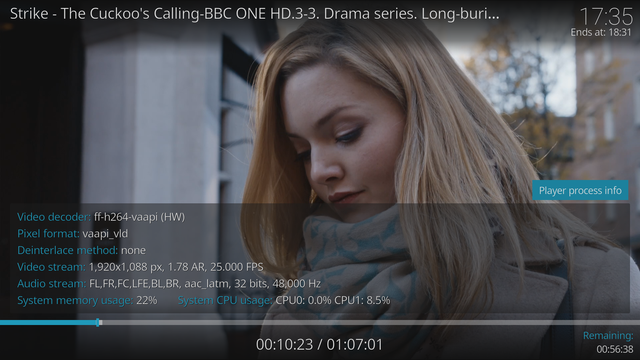OK - checked some 5.1 stuff from BBC One HD in the UK.
This is from last Sunday's episode of Cormoran Strike - both DVB-T2 AAC 5.1 and DVB-S2 AC3 5.1


Both play as files and from within the TV Headend PVR client with no problems on my Haswell Celeron Chromebox running LibreElec 8.0.2. I'm configured for 5.1 output over HDMI and my amp is being sent 5.1 PCM with the AAC clip and bitstreamed AC3 for the AC3 clip. I have no audio glitching.
My AAC 5.1 BBC One HD recording has the following properties from Media Info (I've snipped the filename, and the EPG EIT stuff from the bottom) BBC HD stuff carries either a 2.0 or 5.1 AAC main programme channel, and then a mono additional audio description channel (for people with visual impairment to audibly describe visual action) which receivers add to the main programme sound feed.
(You'll also note the video is flagged progressive. This is because UK H264 HD encoders on DVB-T2 switch between i25 and p25 encoding on-the-fly. The Media Info is actually for a short clip I created using 'dd' to crop the first 500MB of the file, as the recording started early and started with the end of a 2.0 AAC show)
Format : MPEG-TS
File size : 200 MiB
Duration : 6mn 46s
Overall bit rate mode : Variable
Overall bit rate : 4 130 Kbps
Video
ID : 6601 (0x19C9)
Menu ID : 17540 (0x4484)
Format : AVC
Format/Info : Advanced Video Codec
Format profile : High@L4
Format settings, CABAC : Yes
Format settings, ReFrames : 4 frames
Codec ID : 27
Duration : 6mn 45s
Width : 1 920 pixels
Height : 1 080 pixels
Display aspect ratio : 16:9
Frame rate : 25.000 fps
Standard : Component
Color space : YUV
Chroma subsampling : 4:2:0
Bit depth : 8 bits
Scan type : Progressive
Color range : Limited
Color primaries : BT.709
Transfer characteristics : BT.709
Matrix coefficients : BT.709
Audio #1
ID : 6602 (0x19CA)
Menu ID : 17540 (0x4484)
Format : AAC
Format/Info : Advanced Audio Codec
Format profile : LC
Muxing mode : LATM
Codec ID : 17
Duration : 6mn 46s
Bit rate mode : Variable
Channel(s) : 6 channels
Channel positions : Front: L C R, Side: L R, LFE
Sampling rate : 48.0 KHz
Frame rate : 46.875 fps (1024 SPF)
Compression mode : Lossy
Delay relative to video : -806ms
Language : English
Audio #2
ID : 6606 (0x19CE)
Menu ID : 17540 (0x4484)
Format : AAC
Format/Info : Advanced Audio Codec
Format profile : HE-AAC / LC
Muxing mode : LATM
Codec ID : 17
Duration : 6mn 45s
Bit rate mode : Variable
Channel(s) : 1 channel
Channel positions : Front: C
Sampling rate : 48.0 KHz / 24.0 KHz
Frame rate : 23.438 fps (1024 SPF)
Compression mode : Lossy
Delay relative to video : -611ms
Language : English
Language, more info : Visual impaired commentary
Text
ID : 6605 (0x19CD)
Menu ID : 17540 (0x4484)
Format : DVB Subtitle
Codec ID : 6
Duration : 6mn 44s
Delay relative to video : 2s 261ms
Language : English
Menu
ID : 6600 (0x19C8)
Menu ID : 17540 (0x4484)
Duration : 6mn 46s
List : 6601 (0x19C9) (AVC) / 6602 (0x19CA) (AAC, English) / 6606 (0x19CE) (AAC, English) / 6605 (0x19CD) (DVB Subtitle, English)
Language : / English / English / English
Service name : BBC ONE HD
Service type : advanced codec HD digital television
Display More

